 Ottoman Navy: Four British built Ironclads (1863-1866):
Ottoman Navy: Four British built Ironclads (1863-1866):Osmanieh, Mahmudieh, Abdul Aziz, Orkanieh
The Osmanieh (or Osmaniye) class were four broadside ironclads built in britain, three at Napier and one at Thames iron works between 1863 and 1866. They were active until the war of 1877-78 with Russia, and swa little action, being preserved by the naval staff to protect Istambul. Same story in 1884 but by that time, after nearly a decade of neglect and limited modernization they were barely operational, with skeleton crews and only sailed in safe ports, kept in readiness. After their modernization of 1890-94 they took part in the 1897 war, but again, in such poor state to not take part in any action, especially against the new Greek Hydra class Ironclads. They made an aegean cruise and returned to complete inactivity and lack of maintenance of training. They became such an ambarrassment for the court in 1900 that a modernization project was signed with Krupp, which eventually withdrawn in 1902. Laid up until 1913 as utility hulks they were scrapped before WWI.
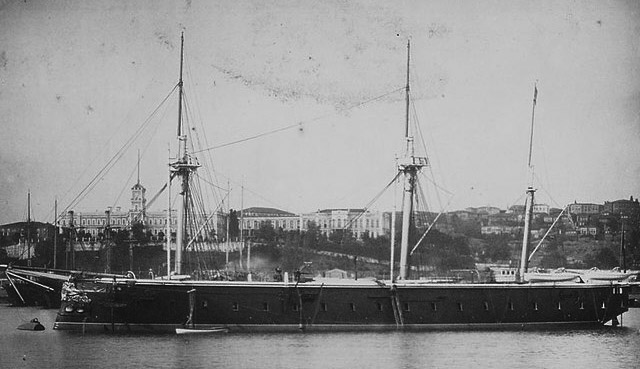
Mahmudiye in Istambul
Context
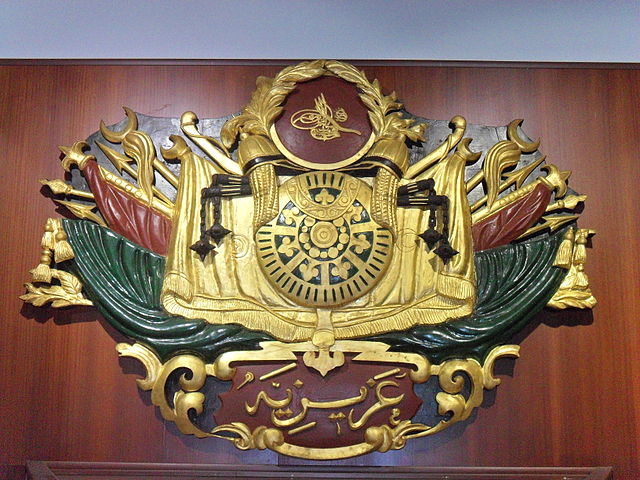
In 1860 the Ottoman Empire still was probably the largest Empire at the time besides Britain. It was present in the Balkans, ruled over parts of Africa, the Middle East and its core Asia Minor. However frequent troubles among the Sultan’s subjects met the ambitions of other rising powers with predatory ambitions. Russia was a good example, posing as the champion of oppressed peoples and Orthodox Christianity, which attempted to progress in the black sea and Balkans. The Ottoman Navy always had been a heavyweight in the black, sea and certainly make its presence felt, especially in the eastern Mediterranean for decades in the XIXth Century. However, relative neglect and defeats in the hands of the west at Navarino in 1827 and Russia at Sinope in 1853. The Greek war of Independence deprived the Empire from skilled sailors in this area, and in 1841 the Egyptian secession deprived the fleet of its best shipyards and seafarers. The next 1855 Crimean war in which the Empire was considered the “sick man of Europe” saw a coalition led by Britain, fearing the rapid rise of the Russian Empire and vowing to preserve a power balance, manage to invert the trend.
Strenght of the Ottoman Navy 1860
Postwar, it was clear in 1860 to the Ottoman naval staff that the Navy was in dire need of modernization and the advent of Ironclads seemed a good solution to off-balance its situation. Apart those built in France, but also Italy and Austria prior to the 1866 battle of Lissa in the West, there were none in the Eastern Mediterranean. The rule of Sultan Abdul Aziz from 1861 (and up to 1876) very much reversed the trend, but at great cost for the Empire, already strained in its land campaigns. In 1860 the Ottoman Navy still boasted impressive assets: 7 line of battle ships, 6 frigates, 4 corvettes, 9 bricks/schooners.
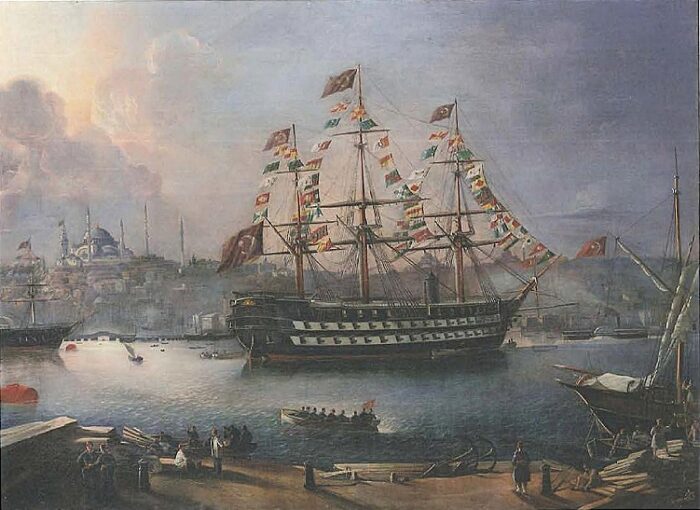
Screw ship of the line Sadieh in full regalia saluting Constantinople, by Hovhannes Umed Behzad 1867
The Ottoman Ironclad craze
Thus in 1862, a military and diplomatic mission was sent to France and Britain to enquire about the possibility of building ironclads for the Ottoman navy, in the hope on the longer run to be able to build these in Constantinople. Britain and its industrial might had the capacity to answer the demand. In particular, Robert Napier and Sons, Govan from Glasgow, Scotland, which also provided the bulk of steam engines for the Royal Navy and ships abroad. The yard had experience with a variety of ships and notably no less than the inaugural ironclads of the RN, HMS Black Prince of the 1861 Warrior class. Napier would also build the Erebus, Hector, Audacious, Invincible, Hotspur, Northampton, the Rolf Krake (1863) for Denmark and the monitors Tijger (1868) and Buffel (1868) for the Netherlands.
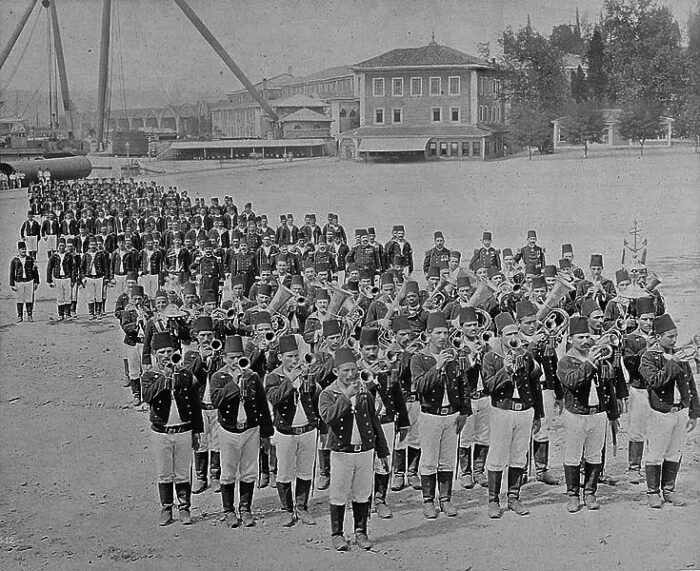
The crew of Orhaniye’s band parade marching
These four ironclads were known as either the Osmaniye or Osmanieh depending of the sources and ways to translate the name from Arabic. Three ordered to Napier, reaching its full capacity, and in complement to Thames Iron Works. The first pair was launched in 1864 and the second pair in 1865, completed in 1865-66. At 6,400t they were by far the largest Ottoman ships ever commissioned to that point, albeit at great cost.
Design of the class
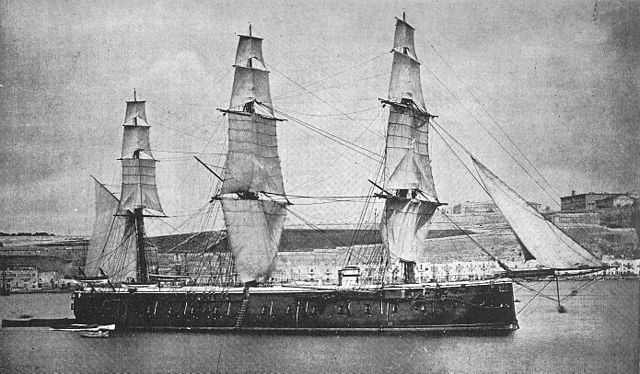
HMS Royal Oak was perhaps one inspiration for the design.
The Osmanieh class were typical of the broadside ironclads built at the time in Britain. They looked like a reduced version of the HMS Royal Oak just launched at the time, three masts, one funnel and a limited ram bow and limited size battery amidships. These Iron-hulled broadside ironclads were laid down in 1863 and completed in 1865-66, rigged as three-masted barques and with a single telescopic funnel. The rig was removed in the 1880s. They had a ram bow with a 4in iron breastwork on the upper deck forward protecting the 9in 12.5t Armstrong ML gun. The 8in 9t Armstrong MLRs were on the upper and main deck broadsides, as were the 36pdr smoothbores. The belt extended 2ft 6in above Iwi and 6ft below amidships, but only 4ft 6in below at the ends.
Hull and general design

Line drawing in Brasseys 1888
The Osmaniye-class Ironclads were certainly not small at 91.4 m (299 ft 10 in) long overall for a beam of 16.9 m (55 ft 5 in) and draft of 7.9 m (25 ft 11 in) and entirely constructed with iron. They displaced 6,400 metric tons (6,300 long tons; 7,100 short tons) at normal load, 4,211 t (4,144 long tons; 4,642 short tons) fully loaded. To compared HMS Royal Oak displaced less at 6,366 long tons (6,468 t) while being shorter at 273 ft (83.2 m) and beamier at 58 ft 6 in (17.8 m). It is understood that the overall length of the Osmanieh probably incorporating the bowsprit. Conways gives 89.31 meters or 293 feet between perpendiculars, but again, it might include the bowsprit. They had a crew of 26 officers and 335 originally. Thus included also the sail crew. This fell to just 250 after 1894.
Protection

The shading represents areas of the hull covered by armor
They were covered with wrought iron plating all over. The armored belt was 140 mm (5.5 in) thick, tapered down to 76 mm (3 in) with transverse bulkhead at either end. The belt extended above the waterline over one meter of 2 ft 6 in and 6 ft (1.8 meters) below amidships, down to 4 ft 6 in or a meter below at each end.
Above the belt were strakes of armor 127 mm (5 in) thick covering the battery, closed also with transverse bulkheads 114 mm (4.5 in) connected the battery armor on both ends.
These ships had a ram bow with a 102 mm (4 inches) iron breastwork on the upper deck forward, which also protected the single deck 229mm 12.5t Armstrong ML gun.
Powerplant
The Osmaniye class ironclads had a Napier single horizontal compound (HDA) steam engine driving a single screw propeller. Steam came from by six rectangular coal-fired box boilers trunked into a single retractable funnel amidships for 3,735 indicated horsepower. The idea of a retractable funnel was to be used under sail. Their was able to procure them 13.5 knots (25 km/h; 15.5 mph) on sea trials which was fast for the time. In 1891 just prior rebuilding decades of poor maintenance halved this to just 6 knots (11 km/h; 6.9 mph). The class also carried 750 tons (740 long tons; 830 short tons) of coal for a range probably around 1,200 nautical miles. They counted on their barque rig of three masts for long range cruising.
Armament
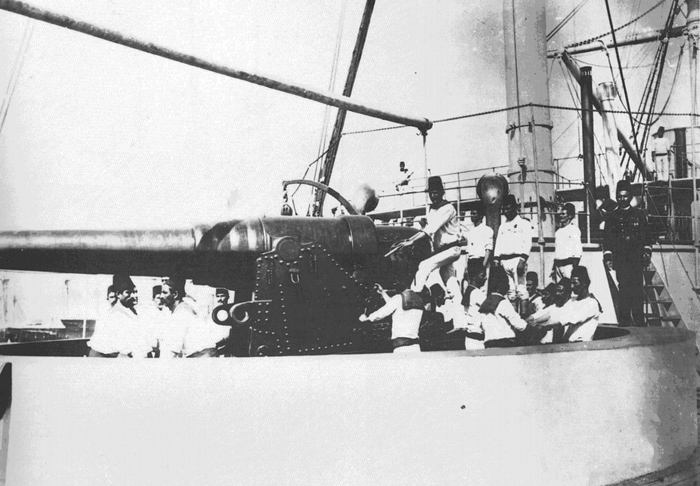
Osmanieh barbette after modernization, 1894
The Osmanieh class came up with a single 229 mm/14 caliber (9 in) rifled muzzle-loading (RML) Armstrong gun on dec forward, partlu shielded behind a breastwork prolongating the ram bow. This was a massive 12.5-ton Armstrong gun mostly capable of chase fire, but also mounted on rails for a generous arc of fire on either side. It was completed below by the battery of fourteen 203 mm (8 in) RML Armstrongs (15 caliber 9 tons), seven amidships either side on the main deck, supplemented with ten 36-pounder ot 175mm 12 caliber guns with some on the upper deck behind massive bulwarks.
This changed in the 1870s already, 1884 and 1892. See below.
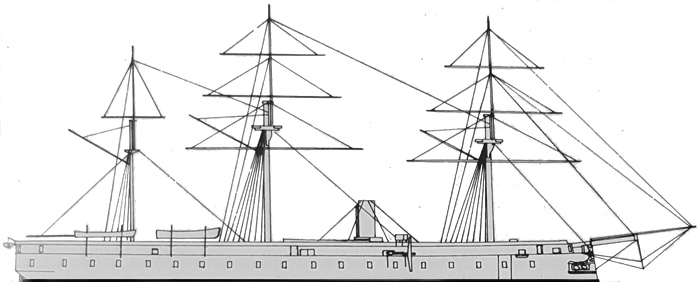
Conways profile
⚙ specifications |
|
| Displacement | 6,400t (6,300 long tons; 7,100 short tons) |
| Dimensions | 91.4 x 16.9 x 7.9m (299 ft 10 in x 55 ft 5 in x 25 ft 11 in) |
| Propulsion | 1 Napier HDR steam engine, 6 rect. boilers, 3,735 ihp |
| Speed | 13.5 knots trials (25 km/h; 15.5 mph) |
| Range | Unlimited with sail, c1200 nm steam, 750t coal |
| Armament | 1x 229mm/14 MLR, 14x 203mm/15 MLR, 10x 175mm/12 36pdr SBML |
| Protection | Belt 140mm Bulkheads 76mm, battery 127mm Bulkheads 114mm |
| Crew | 26 officers+ 335 ratings |
Modernizations
1884 modernization
Modernizations in 1884 for all included the removal of ten 175mm/12 or 36 pdr RML for the addition of four 47mm/37 SK L/40 C/99 Krupp guns and two quadruple 25mm/42 Nordenfelt guns. They became central battery ships, albeit ten years late. Having only a light battery of four quick-firing Hotchkiss guns and two Nordenfelt guns came in complement of their older battery, the 229 mm and 203 mm guns were kept.
1890s modernization
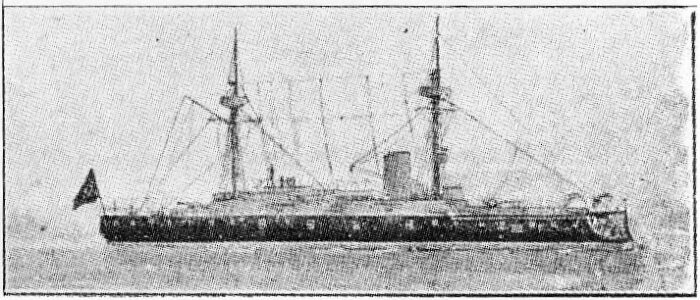
Osmanieh as rebuilt 1890s
By 1890 the forward 9-in had been replaced by two 5.9m (2 x 1) and a 9.2in was mounted aft. Abdul Aziz was renamed Azizieh in about 1870, and was modernised with Osmanieh by Ansaldo at Genoa in 1890-91. Orkanteh and Mahmudieh were modernised by the same firm between 1892 and 1895. They were converted to central battery ships, and were rearmed with 2-9.2in/35 Krupp BL (2 x 1), 8-5.9in/25 Krupp BL (8 x 1), 6-4. in Krupp QF (6x 1), 4-47mm (4x 1) and 2-14in TT (2.x 1). The 9.2in were mounted fore and aft in 10-in wooden barbettes plated with 3in steel and had lin Shields. The 5.9in and 4.lin were on the broadside amidships. They were cut down fore and aft and fitted with a CT and two military masts.
The original machinery was retained but they were fitted with cylindrical boilers. Their normal displacement was reduced to 6,299t. In 1904 it was proposed to reconstruct them, but they were in such poor condition that this was not carried out. They were to have been re-engined, reboilered, and rearmed with 1-8in/45 QF and 9-5.9in QF. New steel armour was to have been fitted, with a 10in belt, Sin barbettes, 3in turrets and a l4in protective deck. They served as hulks during World War I and were scrapped after the war (Conways).
In 1890-1894, were modernized at Tersane-i Amire Royal Arsenal and yard and Ansaldo but fitted out at Istanbul Osmaniye and Aziziye and in 1892-1894 for Orhaniye and Mahmudiye.
They were completely re-engined, reboilered with 2 shafts 2 VTE, 6 cylindrical boilers rated for 3,735 shp total and a top speed of 10 knots, Mahmudiye reached 12.5kts on trials. Armaments wise they received two barbette 240mm Krupp guns (13mm barbettes, 25mm shields) and a conning tower. The main Krupp guns were listed as 240 mm but were in reality 235mm/32 MRK L/35 C/86 Krupp guns. In addition they had eight 149mm/22 RK L/25 C/75 Krupp secondary guns on both sides, under shields and bulwark, then five 105mm/32 SK L/35 C/86, and two 47mm/40 Hotchkiss QF guns plus seven quad 25mm/42 Nordenfelt. Displacement rose to 6,299t, almost 1,800t more than as built. They also had two military masts fore and aft. Very different beast indeed.
The nature of the refit is unclear.
Bernd Langensiepen and Ahmet Güleryüz describes extensive modernization with two vertical triple-expansion engines in place of her original machinery, and six coal-fired Scotch marine boilers replaced the box boilers, speeed of 10 knots (19 km/h; 12 mph). Armament comprising new Krupp breech-loading guns were installed. Two Krupp 240 mm (9.4 in) K L/35 guns were added in individual barbettes, one forward and one aft. Eight 150 mm (5.9 in) L/25 Krupp guns and six 105 mm (4.1 in) L/25 Krupp guns were installed on the broadside. Two of the 47 mm guns were removed and three more Nordenfelt guns were added.
Ian Sturton reported less significant alterration made with only half of the original main battery guns removed, six sponsons for light guns were added to the upper deck, three per side. The full modernization for him only concerned Osmaniye and Aziziye, showing as proof a photograph dated 1898 showing Orhaniye showing less alterations than her sisters.
A rather obscure career
Unlike most of ironclads of the Ottoman fleet, they were kept out of action in the Russo-Turkish War of 1877–1878, being preserved to defend the Capital as the most powerful vessels of the fleet. They were kept during that war all along in the Sea of Marmara, albeit Osmaniye carried briefly troops in the Mediterranean. Postwar they went into reserve status in Constantinople, were heavily rebuilt in the early 1890s as barbette ships in Italy. Nevertheless conditions detetoriated so much they were hopeless for the Greco-Turkish War in February 1897. Training in May showed also the very low training standard of their crews.
All four ships were disarmed after the war and laid up and the reconstruction program included the four Osmaniye-class at first, with propositions such as a new propulsion system and a new battery of one 203 mm QF and nine 150 mm QF guns, and a modern steel armor, notably a 254 mm (10 in) thick belt and 127 m (5 in) thick barbettes, 76 mm (3 in) gun turrets, and 38 mm (1.5 in) thick deck. But this was dropped. None saw either the 1912 Balkan war nor WWI as they were all discarded in 1911, albeit they lingered as utility hulks before being Sold for scrap in 1913, Aziziye and Osmaniye were scrapped in 1923.
Career of the Osmanieh class
 Osmaniye (1864)
Osmaniye (1864)
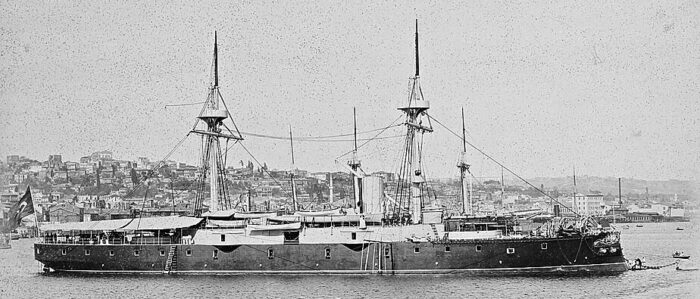
Osmanieh after her 1890s reconstruction
Osmaniye was ordered in 1862, keel laid down in March 1863, launched on 2 September 1864, and initially named “Gazi Osman”. Sea trials started on 27 June 1865, under her new named honoring Sultan Osman I, the Ottoman Empire’s founder. She was commissioned in November 1865 and joined her sister into the main Ottoman combat squadron, activated every summer for short cruises. Generally they headed from the Golden Horn to the Bosporus and worked out their propulsion systems, with rare gunnery drills.
The Ottoman fleet mobilized in September 1876 for an upcoming war with Russia, after an insurrection in Bosnia started in mid-1875. Serbia declared both its independence and war on the Ottoman Empire in July 1876, rececing full support from the Tsar. The Russo-Turkish War started on 24 April 1877 with a Russian declaration of war, but the Ottoman admirakty decided to keep Osmaniye and her sisters in the Mediterranean Fleet and close to the Capital, fearing to loose them. Instead, its wooden warships operated from April 1877 off Albania. At solme point, the battle squadron led by Osmaniye sailed to Souda Bay in Crete. In January 1878, Russian forces closed on the capital through the Balkans, so the battle squadron returned, transporting a reserve army from Dedeagac to Gelibolu. Osmaniye and Sultaniye carried the last elements of the army on 31 January 1878. But she saw no action afterwards.
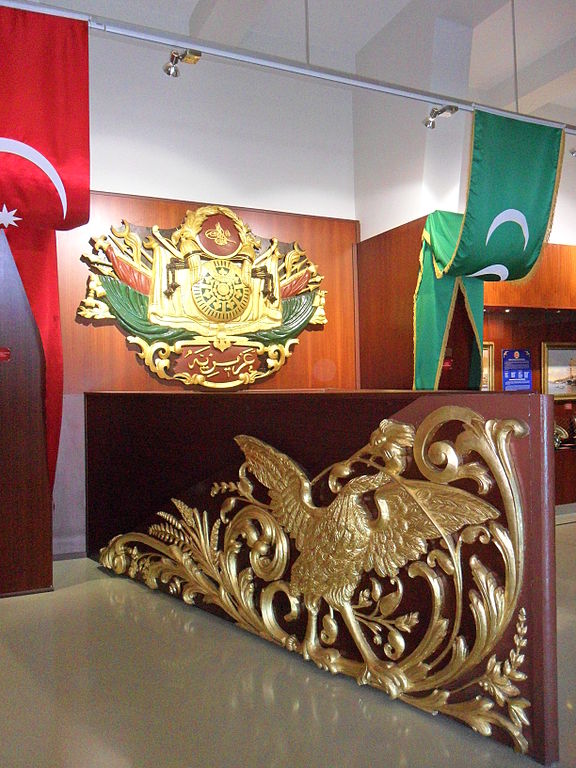
Aziziye’s decorations exhibit
Osmaniye was laid up in Constantinople postwar and no longer saw summer cruises to the Bosporus. They were activated for short runs in the Golden Horn but with part-time crews this was not an easy task. By 1883, these ships due to years of neglect as the Navy was underfunded, was in poor condition. Osmaniye turned out to be inoperative and the best of these ironclads could not even rise steam enough to make a knot. Training standards were appealing. The engines caught rust, the original boilers were completely clogged, the hulls were badly fouled after having no drydock time since construction. The British naval attache reported at least a work of six months to make them seaworthy again. They also had a skeleton crew of 1/3 their normal complement.
In 1884, she was modernized, and in 1885–1886, it was tried to have her rearmed with Krupp breeck-loading fortress guns, manufactured in the mid-1870s, a work completed in 1886. The four ironclads went at sea to test these new guns, and paraded in front of the Golden Horn in 1887. Tension with Greece in 1886 forced to crew them fully, and restart training. However it was decided to not use them and they were laid up. The least perfoming was capable of 4 knots, and the best, 6 knots (7.4 to 11.1 km/h; 4.6 to 6.9 mph).
Osmaniye was refitted at the Imperial Arsenal in 1890-1894, having her main battery strengthened, upper deck cut down forward and aft, barbettes installed. The machinery was modernized and she was capable of reaching 10 knots (19 km/h; 12 mph). Hiowever after working up with the full crew in 1894-96 she was laid up against in 1897 in Çanakkale.
With the Greco-Turkish War flaring up in February 1897, Osmaniye was fully crewed and joined the 1st Squadron. After inspection however it was believed she was unfit for combat against a modernized Greek Navy and its Hydra-class ironclads.
Inspectors indeed realized that the absence of machinist’s and gunnery training let to serious mishaps. Notably the pistons on their Krupp guns were bent so they could not traverse. In April-May, the Ottoman fleet sortied with these shops anyway to the Aegean Sea but it was only to show the flag and raise morale. On 15 May, Osmaniye trained its crew, despite the inoperative guns. Eventually after the war she was withdrawn from service and the guns were removed.
British Admiral Henry Wood and the German Admiral Eugen Kalau vom Hofe inspected the fleet, which turned out to be an embarrassment. Sultan Abdul Hamid II authorized at last a modernization program and recommanded a new modernization in foreign shipyards, buut soon singled-out on the German Empire’s firms, Krupp, Schichau-Werke, and AG Vulcan. All three sent engineers to review the ships and witdrew in December 1897. In addition the Ottoman government was unwilling to pay for the work, but since the Kaiser looked for constitute a bulwark of central Empires from Berlin to Constantinople via Vienna to deal with the West and Russia, negotiations led to potential subsidies assurances given to Krupp for a contract signed on 11 August 1900. By December 1902 Krupp withdrew ultimately given the poor state of the ships. Osmaniye and none her sisters had their last refir. In 1908, Osmaniye was towed to Constantinople and decommissioned there on 31 July 1909, albaiet still listed in 1923, she was a hulk when sold for BU.
 Azizieh (Abdul Aziz)
Azizieh (Abdul Aziz)
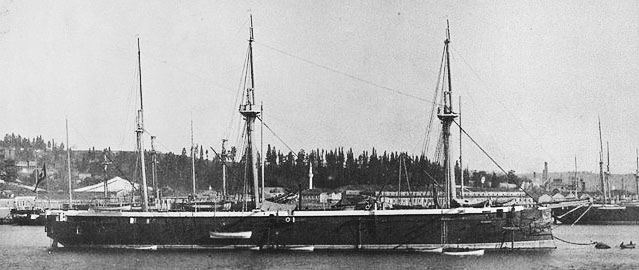
Aziziye was ordered in 1862 as Abdül Aziz at first, laid down at Napier in May 1863, launched in January 1865, commissioned in August as Aziziye. Her career resembled strongly her sister. She was activated every summer for short cruises and was mobilized in September 1876 for the war with Russia, and in early 1877, assigned to the 2nd Division, Mediterranean Fleet in Crete with the other ironclalds Mukaddeme-i Hayir and Iclaliye. The Russo-Turkish War flared with war declared on 24 April 1877 but she did saw no action, remaining in Souda Bay.
After the war in 1878 she was laid up in Constantinople.
Due to her poor condition after years of neglect under Abdul Hamid in 1884, she had a gunnery refit like her sisters. In 1886, she was mobilized for the war with Greece but did not left the Golden Horn, laid up again. She was refitted at the Imperial Arsenal from 1890 to 1894. With the Greco-Turkish War in February 1897 she was mobilized into the 1st Squadron and on 19 March, Aziziye, Mesudiye, Hamidiye, and Necm-i Şevket rescorted by three torpedo boats departed the Golden Horn for the Dardanelles. They sailed off Lapseki on 22 March. Two torpedo boats judged too unseaworthy left them. An inspection founf none was fit for combat. For Azizieh in addition of having pistons on her Krupp guns bent, breeches for for her main guns were missing, stored at the Imperial Arsenal…
In April-May, she still sortied into the Aegean Sea to raise morale, and she escorted troopships with Necm-i Şevket and the river monitor Hizber from western Anatolia to Gelibolu. She had gunnery training outside the Bosporus howing again her unreadiness. On 15 May she sailed with Mesudiye, Necm-i Şevket, Osmaniye, and Hamidiye in a major training exercise which definitvely proved she was unfit for combat.
Sultan Abdul Hamid II authorized a half-hearted modernization program, asked German yards to answer a tender, but finances were lacking, as the enthusiasm of these Yards including Krupp, contracted on 11 August 1900, and retracting bu December 1902. Aziziye became a barracks ship in 1904 in Kasımpaşa. She was decommissioned on 31 July 1909 and kept listed until 1923, sold for BU.
 Orhaniye
Orhaniye

Orhaniye was built at Napier, ordered in 1862, laid down in 1863, launched on 26 June 1865 and in sea trials by 1866, commissioned soon after. She took part of summer cruises from the Golden Horn to the Bosporus. In September 1876 she was mobilized for the war with Russia, assigned to the 2nd Division, Mediterranean Fleet in Crete with Muin-i Zafer and Asar-i Tevfik. Orhaniye however remained in Souda Bay for the duration of the war.
She was laid up in Constantinople in 1878 and the Sultan decided to shring radically the n,aval budget. Annual summer cruises ended as well as all form of maintenance or training. By the mid-1880s she was inspected and declard unable to go to sea. In 1884. She was rearmed and somewhat resored in operational conditions. She was mobilized during the war with Greece in 1886 but went nowhere like her sisters.
She was refitted at the Imperial Arsenal from 1892 to 1894 but after the Greco-Turkish War in February 1897, despite being mobilized into the 1st Squadron she was inspected, revealing useless guns. In April-May, she sortied for show into the Aegean Sea and postwar she was withdrawn frol service and dsiarmed, laid up at Çanakkale.
Under Sultan Abdul Hamid II she was scheduled for modernization but this fell though as Krupp refused to do so by December 1902. She was towed to Constantinople, decommissioned on 31 July 1909, became a barracks ship in Kasımpaşa until 1913, and BU.
 Mahmudieh
Mahmudieh

Mahmudiye (After Sultan Mahmud II) was the only one built at Thames Iron Works shipyard in Blackwall, London, laid down 1863, launched 13 December 1864, completed for sea trials in 1865, commissioned in 1866.
She took part in every summer training cruises to the Bosporus. By September 1876 she was mobilized and assigned to assigned to the 1st Division, Mediterranean Fleet in Volo, Aegean, with Asar-i Şevket. She was kept there until the end of the conflict and then was laid up in Constantinople. Like the rest she was found in poor condition with unusable engines, completed rusted with a hull badly fouled. In 1884 she landed her 36-pounder guns and received more modern ones. In 1886, she was capable of some navigation at low speed.
She had another refit from 1892 to 1894.
In the war of 1897, she joined the 1st Squadron and in April-May was part of the fleet cruise in the Aegean Sea to raise morale. Postwar she was withdrew and disarmed, laid up at at Çanakkale. By December 1897 there was a torough inspection leading to a modernization order to Krupp signed on 11 August 1900. By December 1902, Krupp withdrew from the deal. Mahmudiye was laid up until 1904, towed to Constantinople, decommissioned on 31 July 1909, hulked, used as barracks ship in Kasımpaşa until 1913, and BU.
Read More/Src
Books
Langensiepen, Bernd & Güleryüz, Ahmet (1995). The Ottoman Steam Navy 1828–1923. London: Conway Maritime Press.
Lyon, Hugh (1979). “Turkey”. In Gardiner, Robert (ed.). Conway’s All the World’s Fighting Ships 1860–1905. Conway Maritime Press.
Sondhaus, Lawrence (2014). Navies of Europe. London: Routledge.
Sturton, Ian. “Through British Eyes: Constantinople Dockyard, the Ottoman Navy, and the Last Ironclad, 1876–1909”. Warship International.
Links
weaponsandwarfare.com command of the black sea
clydeships.co.uk/
navypedia.org osmaniye
worldnavalships.com turkish_navy
transportsofdelight.smugmug.com
Ottoman_ironclad_Osmaniye
commons.wikimedia.org/
wikimili.com/en/
awargamingodyssey.blogspot.com
Videos
Model Kits
Osmaniye Turkish Barbette Ship 1897-1923 by Fairy Kikaku No. S053 1:700

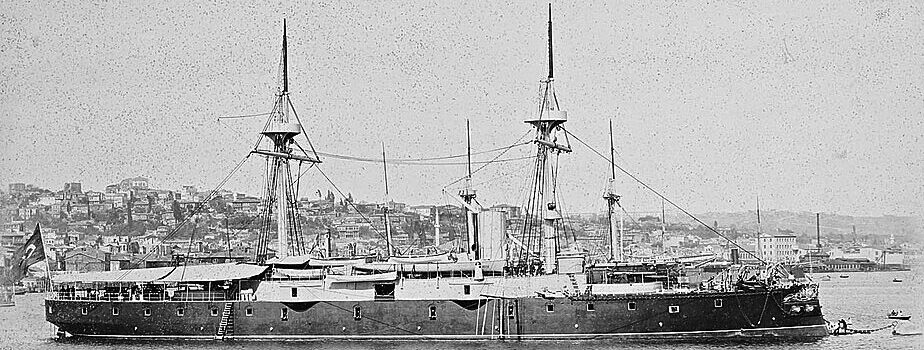
 Latest Facebook Entry -
Latest Facebook Entry -  X(Tweeter) Naval Encyclopedia's deck archive
X(Tweeter) Naval Encyclopedia's deck archive Instagram (@navalencyc)
Instagram (@navalencyc)





 French Navy
French Navy Royal Navy
Royal Navy Russian Navy
Russian Navy Armada Espanola
Armada Espanola Austrian Navy
Austrian Navy K.u.K. Kriegsmarine
K.u.K. Kriegsmarine Dansk Marine
Dansk Marine Nautiko Hellenon
Nautiko Hellenon Koninklije Marine 1870
Koninklije Marine 1870 Marinha do Brasil
Marinha do Brasil Osmanlı Donanması
Osmanlı Donanması Marina Do Peru
Marina Do Peru Marinha do Portugal
Marinha do Portugal Regia Marina 1870
Regia Marina 1870 Nihhon Kaigun 1870
Nihhon Kaigun 1870 Preußische Marine 1870
Preußische Marine 1870 Russkiy Flot 1870
Russkiy Flot 1870 Svenska marinen
Svenska marinen Søværnet
Søværnet Union Navy
Union Navy Confederate Navy
Confederate Navy Armada de Argentina
Armada de Argentina Imperial Chinese Navy
Imperial Chinese Navy Marinha do Portugal
Marinha do Portugal Mexico
Mexico Kaiserliche Marine
Kaiserliche Marine 1898 US Navy
1898 US Navy Sovietskiy Flot
Sovietskiy Flot Royal Canadian Navy
Royal Canadian Navy Royal Australian Navy
Royal Australian Navy RNZN Fleet
RNZN Fleet Chinese Navy 1937
Chinese Navy 1937 Kriegsmarine
Kriegsmarine Chilean Navy
Chilean Navy Danish Navy
Danish Navy Finnish Navy
Finnish Navy Hellenic Navy
Hellenic Navy Polish Navy
Polish Navy Romanian Navy
Romanian Navy Turkish Navy
Turkish Navy Royal Yugoslav Navy
Royal Yugoslav Navy Royal Thai Navy
Royal Thai Navy Minor Navies
Minor Navies Albania
Albania Austria
Austria Belgium
Belgium Columbia
Columbia Costa Rica
Costa Rica Cuba
Cuba Czechoslovakia
Czechoslovakia Dominican Republic
Dominican Republic Haiti
Haiti Hungary
Hungary Honduras
Honduras Estonia
Estonia Iceland
Iceland Eire
Eire Equador
Equador Iran
Iran Iraq
Iraq Latvia
Latvia Liberia
Liberia Lithuania
Lithuania Mandchukuo
Mandchukuo Morocco
Morocco Nicaragua
Nicaragua Persia
Persia San Salvador
San Salvador Sarawak
Sarawak Uruguay
Uruguay Venezuela
Venezuela Zanzibar
Zanzibar Warsaw Pact Navies
Warsaw Pact Navies Bulgaria
Bulgaria Hungary
Hungary

 Bundesmarine
Bundesmarine Dutch Navy
Dutch Navy Hellenic Navy
Hellenic Navy Marina Militare
Marina Militare Yugoslav Navy
Yugoslav Navy Chinese Navy
Chinese Navy Indian Navy
Indian Navy Indonesian Navy
Indonesian Navy JMSDF
JMSDF North Korean Navy
North Korean Navy Pakistani Navy
Pakistani Navy Philippines Navy
Philippines Navy ROKN
ROKN Rep. of Singapore Navy
Rep. of Singapore Navy Taiwanese Navy
Taiwanese Navy IDF Navy
IDF Navy Saudi Navy
Saudi Navy Royal New Zealand Navy
Royal New Zealand Navy Egyptian Navy
Egyptian Navy South African Navy
South African Navy






























 Ukrainian Navy
Ukrainian Navy dbodesign
dbodesign